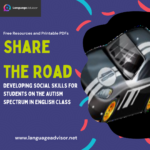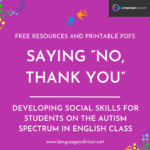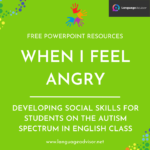Praising Accomplishments – Developing Social Skills for Students on the Autism Spectrum in English Class. Free Resources and Printable PDFs
Praising Accomplishments – Developing Social Skills for Students on the Autism Spectrum in English Class

Praising Accomplishments
Supporting students on the autism spectrum in developing social skills is a key part of their educational journey. Social interaction can be challenging for many students with autism, but English class offers a structured and supportive environment where these essential skills can be nurtured. Whether you are a teacher, parent, or caregiver, the right tools can help students with autism thrive socially.
In this blog post, we’ll discuss strategies to develop social skills in English class and offer free printable PDFs with activities and resources specifically designed to support students across the autism spectrum. These resources aim to improve communication, interaction, and understanding while fostering confidence and inclusion in the classroom.
Why Focus on Social Skills in English Class?
English class is more than just reading and writing—it’s a space where students engage in conversations, group projects, and role-playing activities. These activities can help students on the autism spectrum:
- Improve communication skills by practicing verbal and non-verbal interactions.
- Build relationships through structured group work and peer interactions.
- Understand social cues like body language and tone of voice through storytelling and character analysis.
Developing these social skills can enhance not just academic success but also students’ overall school experience, helping them feel more connected to their peers.
Key Social Skills to Develop
When working with students on the autism spectrum, it’s important to focus on specific social skills that can be reinforced in the classroom. These include:
- Nonverbal Communication: Recognizing body language, facial expressions, and gestures.
- Conversational Skills: Learning to take turns in conversations, staying on topic, and asking appropriate questions.
- Empathy and Emotional Understanding: Understanding and responding to others’ emotions.
- Problem-Solving in Social Situations: Learning strategies for handling conflicts and misunderstandings.
- Teamwork and Cooperation: Participating in group activities while understanding the dynamics of collaboration.
Free Printable PDF Resources
We’ve created a set of free printable PDFs that can be easily integrated into your lessons to help students on the autism spectrum develop their social skills. These resources are designed to be adaptable for different age groups and ability levels. Here’s a look at what’s included:
1. Social Stories for Classroom Interaction
Social stories are an effective tool for preparing students for specific social situations. These printable PDFs contain simple narratives that explain common classroom scenarios, such as:
- How to ask a question in class.
- How to participate in a group discussion.
- What to do when you feel confused or upset.
These stories help students predict and understand social expectations, reducing anxiety and building confidence in social settings.
2. Role-Playing Scenarios
Role-playing activities allow students to practice real-life interactions in a safe and controlled environment. Our PDFs include role-playing exercises where students can:
- Practice starting and maintaining a conversation.
- Work through scenarios like sharing opinions and resolving conflicts.
- Greet classmates and engage in polite conversation.
These activities encourage active participation and help students practice their conversational skills.
3. Emotion Recognition Worksheets
Understanding emotions is a key social skill. These worksheets help students on the autism spectrum identify and interpret emotions through facial expressions and body language. Students will:
- Match facial expressions to the correct emotion.
- Discuss what might cause different feelings like happiness, sadness, or frustration.
- Practice responding appropriately to emotions in social interactions.
4. Conversational Turn-Taking Cards
Taking turns in conversations can be challenging for students on the autism spectrum. Our turn-taking cards help students practice conversational flow, including:
- Listening to others and waiting for their turn to speak.
- Staying on topic and responding to what others say.
- Using visual cues to maintain eye contact and show interest.
These printable cards are great for one-on-one practice or small group activities to develop better communication habits.
5. Collaboration and Teamwork Worksheets
Group work can be a significant challenge for some students on the autism spectrum. These worksheets help students understand the importance of collaboration and how to be a supportive teammate. Topics include:
- Sharing tasks fairly within a group.
- Respecting others’ opinions during a discussion.
- Solving problems together in a respectful and cooperative manner.
How to Use These Resources
These free printable PDFs can be integrated into your English class in several ways:
- Warm-Up Activities: Use social stories or role-playing at the start of class to help students prepare for social interactions before beginning the academic lesson.
- Group Work Support: When students are working in pairs or teams, use the collaboration worksheets to help guide them through social and cooperative behaviors.
- Individual Support: For students who may need more focused assistance, use the emotion recognition worksheets or conversational cards in one-on-one settings.
Conclusion
Helping students on the autism spectrum develop social skills is an essential part of their education, and English class provides an ideal environment to practice these skills. With the right strategies and resources, students can improve their communication, build stronger relationships, and participate more confidently in social interactions.
We hope that these free printable PDFs provide you with valuable tools to support students on the autism spectrum in developing these important skills. Download the resources today and create a more inclusive, supportive classroom where every student can thrive.
By using these resources, you can help students on the autism spectrum navigate social interactions in a fun and structured way, setting them up for success both inside and outside the classroom. Happy teaching!

Praising Accomplishments
DOWNLOAD THE PDF FOR FREE





